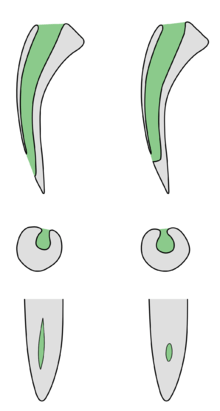Spitting cobra

Spitting cobras on the right.
1: Section of the whole fang in the sagittal plane.
2: Horizontal section through the fang at the discharge orifice.
3: Frontal view of the discharge orifices.

A spitting cobra is any of several species of cobras that can project venom from their fangs when defending themselves.
Spitting cobra venom
The sprayed venom is harmless on intact mammalian skin, but can cause permanent blindness if introduced to the eye; if left untreated it may cause chemosis and corneal swelling.
The venom sprays out in distinctive geometric patterns when muscles squeeze the glands to squirt it out through forward-facing holes near the tips of the fangs.[1] Individuals of some species of spitting cobras make hissing exhalations/lunging movements of their heads when "spitting", and it has been argued that such actions assist in propelling the venom, but research does not support the hypothesis that they play any major functional part except possibly enhancing the threatening effect of the behaviour.[2][3] When cornered, some species "spit" their venom as far as 2 m (6.6 ft). While spitting typically is their primary form of defense, all spitting cobras also can deliver venom by biting. Most spitting cobras' venoms are significantly cytotoxic, apart from the neurotoxic effects typical of other cobra species.
Species of the spitting cobras
African:
- Giant spitting cobra
- Naja katiensis
- Naja mossambica
- Naja nigricincta
- Naja nigricollis
- Naja nubiae
- Naja pallida
Asiatic:
Other spitting species
Certain cobras, especially some Asian species that are not regarded as spitting cobras, do sometimes spit to some extent, though not as effectively as the spitters. Even some of the Viperidae have been reported to spit occasionally.[4]
Among several viper species reported to "fling" or even "spit" venom forward in a spray when threatened, the Mangshan pitviper is particularly notable for consistent and well-aimed spraying of its venom.
The rinkhals (Hemachatus haemachatus) is another elapid species, which, while not belonging to the cobra genus Naja, is closely related and spits venom as its primary defence.
References
- ↑ Young, B. A.; Dunlap, K.; Koenig, K.; Singer, M. (September 2004). "The buccal buckle: The functional morphology of venom spitting in cobras". Journal of Experimental Biology. 207 (20): 3483–3494. doi:10.1242/jeb.01170. PMID 15339944.
- ↑ Berthé, Ruben Andres. Spitting behaviour and fang morphology of spitting cobras. Doctoral thesis, Rheinischen Friedrich-Wilhelms-Universität, Bonn, April 2011.
- ↑ Rasmussen, Sara; Young, B.; Krimm, Heather (September 1995). "On the 'spitting' behaviour in cobras (Serpentes: Elapidae)". Journal of Zoology. 237 (1): 27–35. doi:10.1111/j.1469-7998.1995.tb02743.x.
- ↑ Wüster, Wolfgang; Thorpe, Roger S. (December 1992). "Dentitional phenomena in cobras revisited: Spitting and fang structure in the Asiatic species of Naja (Serpentes: Elapidae)" (PDF). Herpetologica. 48 (4): 424–434. JSTOR 3892862.
- Greene, Harry W. (1997) Snakes: The Evolution of Mystery in Nature. University of California Press, Berkeley and Los Angeles, California.
External links
| Wikimedia Commons has media related to Spitting cobras. |
- Video of an African red spitting cobra spraying its venom
- Video of an African red spitting cobra feeding
- Discovery News 'Spitting Cobras' Sharp-Shooting Secrets"